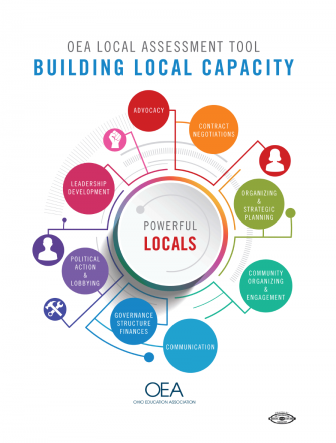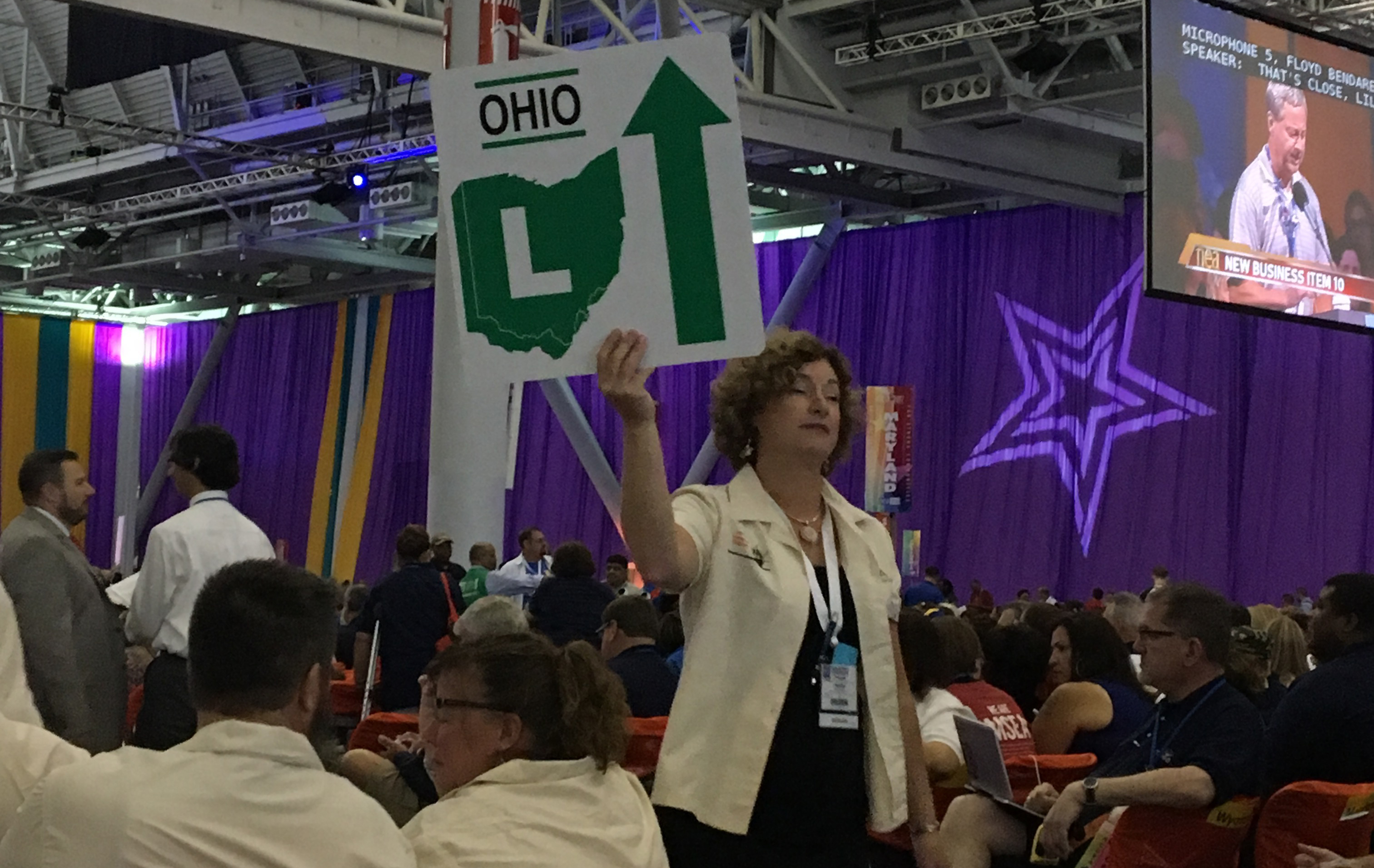June 2018 Ohio Schools
-
- COVER STORY:Celebrating School — 20th Annual Create-A-Cover Contest highlights what students like most
- Samantha Conners, grade 12, Hilliard Darby HS
- Tips for welcoming new educators
- Breakfast in the classroom
- Anti-public education interests use Janus case to further their agenda
- Political Action — Cordray for Governor
- 2018 Fiscal Fitness Award Winners
- Updates — Legislative and Retirements
Moved recently? Contact the OEA Member Hotline to update the address on file at 1-844-OEA-Info (1-844-632-4636) or email, membership@ohea.org. Representatives are available Monday-Friday, from 8:30 a.m. to 6 p.m. | OhioSchools — Past Issues

 Oh Yes, We’re Social — Join the Conversation!
Oh Yes, We’re Social — Join the Conversation!
- COVER STORY:Celebrating School — 20th Annual Create-A-Cover Contest highlights what students like most
Ohio Education Association Endorses Cordray for Governor
The Ohio Education Association (OEA) Fund for Children and Public Education (FCPE) has unanimously endorsed Richard Cordray (D) for Governor of Ohio. The vote was taken at an FCPE convention on Saturday, May 19, 2018, in Columbus.
“Richard Cordray displayed an impressive understanding of the key issues that Ohio’s next Governor will face – from the need to invest more in the state’s public schools and less in poor-performing charter schools. He also understands the need to halt the over-reliance on standardized tests to measure student growth and to evaluate teacher performance,” said OEA President Becky Higgins. “He inspired our members with his commitment to make public education a top priority and to enhance universal pre-K programs that will set Ohio’s children on the path to success.”
The OEA FCPE State Council, comprised of elected OEA members from throughout Ohio carefully screens candidates based on their voting records, their stated support of public education and the OEA’s priority issues. The Republican candidate for Governor, Attorney General Mike DeWine, was invited to participate but declined to attend.
“We believe Richard Cordray has the leadership skills to address the many challenges the state will face in the years ahead,” said Higgins. “Educators, students, parents and all Ohioans will be well-served by his election.”
The Ohio Education Association represents 125,000 teachers, faculty members and support professionals in Ohio’s public schools, colleges, and universities.
Ohio Education Association elects new Secretary-Treasurer
Immediate Release

(Columbus) – On Friday, May 11, Mark Hill of the Worthington Education Association, was elected Secretary-Treasurer of Ohio’s largest association of public employees, the Ohio Education Association (OEA).
Hill was elected by OEA’s Representative Assembly, the governing body of the organization. The Representative Assembly is comprised of more than 1,100 elected delegates from local education associations throughout Ohio. Hill will serve a three-year term beginning July 15, 2018. He replaces outgoing Secretary-Treasurer Tim Myers who is term-limited.
Hill is a 30-year middle school math teacher with Worthington City Schools. He has served since 2010 as President of the Worthington Education Association and has been a member of the bargaining team for four contracts. Mark has served as Chair of the Political Action and Finance Committees for Central OEA/NEA and as Chair of the OEA Resolutions Committee. Mark is currently a member of the OEA Board of Directors and is the Chair of the Strategic Priorities Oversight Committee. Mark has served on the board of the State Teachers Retirement System since 2010.
The Ohio Education Association represents 125,000 teachers, faculty members and support professionals in Ohio’s public schools, colleges and universities.
###
Categories
2018 Press ReleasesCommunications and Community Engagement
Education Policy and Governing Bodies
Education Support Professional
Higher Education Faculty
Higher Education Staff
Local Leader
New Teacher
Non-educator
OEA Member
preK-12 Teacher
Representative Assembly
Retired Member
Student Member
Union Business
February 2018 Ohio Schools
Members Only
This content is for OEA members only. If you are a member, please click the button below to log in.
If you are a member but haven't registered before, please click here to register.
OEA Says ECOT Students Will be Welcomed in Local Public Schools
The President of the Ohio Education Association, Becky Higgins, said today that parents who are disappointed by the closing of the state’s largest online charter school, the Electronic Classroom of Tomorrow, should consider their local public schools as a viable option for their children.
“I think parents will find a hospitable environment in local public schools,” said Higgins, “where students are taught by dedicated professionals who care deeply about serving the educational needs of the children in their classrooms. Local public schools provide a stimulating experience for students where they are given every opportunity to reach their full potential. OEA encourages ECOT parents to take a look for themselves.”
The Ohio Education Association (ohea.org) represents 124,000 teachers, faculty members and support professionals in Ohio’s public schools, colleges and universities
Follow OEA @OhioEA on Facebook, Twitter, YouTube, Instagram, and Pinterest.
December 2017 Ohio Schools
- IN THIS ISSUE
- In Wellston, climate science lessons offer a learning opportunity for educators, students and the community
- OEA locals help elect 84 pro-public education candidates
- OEA locals help elect 84 pro-public education candidates
- Portage County EA DD members return to work following 50-day strike
- the OEA Advocacy & Organizing Institute
- schools prepare for loss of federal funding for children’s health coverage, and more
Moved recently? Contact the OEA Member Hotline to update the address on file at 1-844-OEA-Info (1-844-632-4636) or email, membership@ohea.org. Representatives are available Monday-Friday, from 8:30 a.m. to 6 p.m. | OhioSchools — Past Issues
![]()
![]() Oh Yes, We’re Social — Join the Conversation!
Oh Yes, We’re Social — Join the Conversation!
![]()
Local Capacity
It takes all of us together to educate the child. And we all love what we do. We also know that whatever affects one is going to affect others, so we advocate and fight for our students and each other. That’s the benefit of belonging to a local association.
OEA Locals Establishing Measurable Goals
 The OEA Organizing Department has developed a Local Self-Assessment Tool that can aide your local in targeting crucial areas of growth. Many locals have already begun to use this tool in order to assist them in strategic planning and goal setting. An active and strong local is always assessing their members’ needs and looking for ways in which to grow collective power. The OEA Local Assessment Tool looks at several key indicators that a well-rounded local should take into consideration for increased growth and strength. These are the following: Advocacy, contract negotiations, organizing and strategic planning, community organizing and engagement, communication, political action and lobbying, leadership development and governance structure/finances.
The OEA Organizing Department has developed a Local Self-Assessment Tool that can aide your local in targeting crucial areas of growth. Many locals have already begun to use this tool in order to assist them in strategic planning and goal setting. An active and strong local is always assessing their members’ needs and looking for ways in which to grow collective power. The OEA Local Assessment Tool looks at several key indicators that a well-rounded local should take into consideration for increased growth and strength. These are the following: Advocacy, contract negotiations, organizing and strategic planning, community organizing and engagement, communication, political action and lobbying, leadership development and governance structure/finances.
The tool is very useful for locals and provides them with an accurate reading on their overall organizational effectiveness and readiness. The process walks the self-assessment team through a number of steps to target areas of growth. Once this is achieved, the findings are discussed, and a consensus is reached, the real work begins.
Once the areas of growth are identified the local should develop a plan that sets up short term and long term (measurable or S.M.A.R.T.) goals. What should be achieved right now? What should we attempt to tackle in the long term? Resources and finances? Responsibility and accountability for the established outcomes? These are all questions to think about as locals plan for the future. You need to know where you are going before you figure out how to get there. One step at a time and strategic planning is the key.
This is also a great opportunity to engage and involve your members to participate and take ownership of the locals’ direction and vision. It provides them with a stronger voice and by doing so, they build a stronger local and union alongside their leaders.
I suggest that smaller locals take “smaller” steps so that the tool does not become cumbersome or overwhelming for them. The Organizing Dept. is now developing a shorter “field version” of the original tool. The Local Assessment Tool can be requested by sending us an e-mail or a hard copy can be obtained from your LRC.
Thank you for all you do and remember to keep ORGANIZING!
Ryan Dunn
OEA Director of Organizing & Member Engagement
dunnr@ohea.org
Strong Local Associations
Sharing your experiences and learning from each other — learning the right things and sometimes the wrong things to do — is easily done when you’re part of the network the Association offers.
Perceptions and Procedures
Lessons from the 2017 NEA RA
Anyone who reads social media related to the OEA/NEA can see that the perception of some of our colleagues is that OEA/NEA isn’t doing enough about certain issues, or worse, isn’t listening to members’ opinions. If that is your perception, let me assure you as a first-time delegate to the NEA RA (Representative Assembly) held this summer in Boston, that our union leaders are listening.
The bulk of the time spent at the NEA RA consisted of presenting and debating New Business Items (NBIs), proposed amendments to current NEA Resolutions, new policies, etc. Anyone could submit an issue or amendment to be discussed on the floor. In our morning meetings with our fellow Ohio delegates, we listened to the recommendations of various OEA committees who had reviewed the upcoming issues and whose members gave us a brief explanation of why they recommended either supporting or opposing the item/amendment. There was frequently a debate, and then the Ohio Caucus voted on a position to take. However, it was made very clear that any delegate could vote however he/she chose. At the RA later that day, with delegates from all states present, and often after very robust debate, we voted. An Ohio communications team held up signs reminding us what our Ohio Caucus decided about the item, but we were not obligated to follow that decision. Sometimes other delegates proposed an amendment to the issue at hand, and the Ohio Communications team then showed signs with our Leadership Team’s recommendation regarding the change. Still, delegates could vote however they wished.
And they did.
If you ever want to see democracy in action, all you have to do is observe the floor of any OEA/NEA RA. If the verbal vote is too close to call, a standing vote occurs. In Boston, I saw friends, colleagues, and roommates next to each other…one standing, one sitting. We sat as a group but we voted as individuals, and it was powerful to see so many people united in respectfully making their opinions known.
The debates leading up to these votes were epic (if you don’t believe me, look up NEA RA memes on twitter!). Sometimes, a debate occurred over one word. For example, we debated whether or not the word “powerful” should be used in an NBI to describe the NEA, and whether or not the word “zealously” should be used to describe a particular action. More substantial issues were debated as well, such as when the NEA should endorse presidential candidates and the new NEA policy on charter schools. At this year’s RA, there were 159 NBIs, three Constitutional Amendments, 12 Standing Rule Amendments, eight Legislative Amendments, 16 Policy Statement Amendments, and 31 Resolution Amendments submitted. Each of these were discussed and debated.
It was my first time attending the NEA RA, which is basically like the OEA RA amped up. I had attended the OEA RA before, and so I thought I knew what to expect. That wasn’t always the case. Some issues that I felt would have short discussions actually spark some of the fiercest debates. In all of these cases, my eyes were opened to another perspective that I had not considered. And in all cases, the voices of the delegates were heard. Sometimes my vote fell on the victorious side and sometimes my vote was for the side that got defeated, but I have no doubt that the end results represented what the majority of the delegates wanted.
Being able to understand how someone else perceives an issue often complicates matters. Understanding someone else’s perception can make your own convictions less black and white. It can muddy your positions. But hearing the viewpoints of other OEA and NEA members is an opportunity for which we should be grateful. It is something we should value, and after attending both an OEA RA and the NEA RA as a delegate for the state of Ohio, I very much appreciate that our association goes to such lengths to hear every viewpoint before voting as a body. I have learned a lot about the process of how the NEA forms its core beliefs and the actions it takes in the name of those beliefs. Because I care very much about the perception of my colleagues in the OEA, I want to assure you that our various viewpoints are being heard at both the state and national levels.
It is no easy task to formulate policies and recommend actions that represent the members of the largest union in the country. The viewpoints of others must be taken into account and there must be a process for allowing that to happen. For me, being a part of the largest democratic deliberative assembly in the world was alternately exhausting and exhilarating, frustrating and gratifying, mind-numbingly boring and absolutely inspiring. It is also categorically vital to maintain our mission to offer the highest quality public education in the world to our students, and to do so while advocating for economic and social justice, diversity, tolerance, and fairness in our schools and in our communities.
I urge you to attend an OEA or NEA RA if you are given the opportunity. I am extraordinarily grateful for the chance to witness firsthand how our union discusses, debates, deliberates, and ultimately decides how to best serve our students and promote our shared values in these challenging times.
Learn more about the OEA Representative Assembly.




